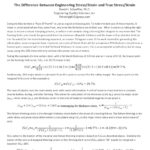Everyone likes to have a “Rule of Thumb” to use as a quick and easy guide. To make the best use of these maxims, it helps to understand where they came from, and what the limitations are in their use.
When it comes to taking the right steps to ensure a robust stamping process, a surface strain analysis using a forming limit diagram is recommended. The forming limit curve should be generated from the minimum allowable thickness and the lower mill production limit (or the -3σ value) for the strain hardening exponent, or n-value. To bypass some of the work involved in generating this information, some companies have chosen to use a rule of thumb that calls for a maximum 20% thickness reduction on a formed part compared with the initial flat blank thickness. In some cases, this is an acceptable substitution, but in many cases, using this 20% threshold only confuses the proper course of action.
More information about how the maximum thinning rule should be applied can be found in THIS FREE DOWNLOAD.
Let Engineering Quality Solutions teach you when and how to use this shortcut!

